#2.12.13
Explore tagged Tumblr posts
Text

8 notes
·
View notes
Text
Hinduism in Naruto: A Study
The world of Naruto is influenced by a number of different cultures, but the references I was most familiar with were those which related to Hinduism. So here is a breakdown of some of those connections, focusing on Otsutsuki clan.
Ashura and Indra Otsutsuki
The words “As(h)ura” and “Indra” appear both in the Vedas, the earliest Hindu scriptures, and in Sanskrit epics of Ancient India depicting Hindu mythology, the Ramayana and Mahabharata.
There are a number of ways to interpret Indra’s role in the Hindu pantheon, but I think it’s easiest to start with Indra in the Rig Veda (earliest of the Vedas). Indra can be understood as a deity who is “King of the Gods” in that text. An early description of Indra’s status: “Mighty is Indra, yea supreme; greatness be his, the Thunderer: Wide as the heaven extends his power.” (Rig Veda 1.8.5)
Trying to explain the meaning of Ashura in Hinduism is more complex; it is not a single deity but a descriptor. In Rig Veda, the word appears numerous times. In the earlier Books, or Mandalas, the connotations of Ashura are that of a powerful being/“god”/“lord.” By the later Books as well in other texts like the Mahabharata, the meaning has transformed to something closer to “demon.”
Looking at Books 1-3 for the Rig Veda*, you can see the more positive connotation for Ashura, meaning “god/lord” associated with Savitr and Agni respectively (which I will touch more upon later).
May he, gold-handed Asura, kind leader, come hither to us with his help and favour. (Rig Veda 1.35.10)
and
Giving delight each day he closeth not his eye, since from the Asura's body he was brought to life. (Rig Veda 3.29.14)
In any case, you can say this of Ashura in the Rig Veda: Indra is placed in a position signifying greatest strength, and Ashura’s position is either that of simply a benevolent lord/god, or later, something much lower status, as a mortal or demon, and aggressor to the gods. This power dynamic is maintained in Naruto, as stated in Chapter 670, when Ashura Otsutsuki is described as a “dunce” compared to the “exceptional” Indra Otsutsuki.
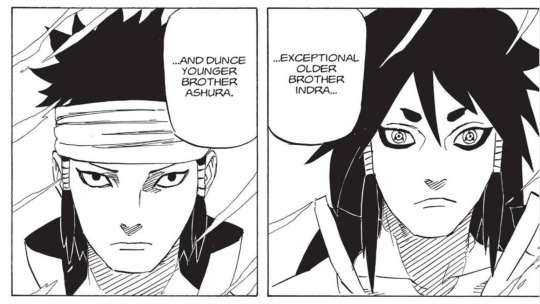
Embodying the conflict between Heavenly People (like Indra) and less divine enemies is this line in Book 10:
This prelude of my speech I now will utter, whereby we Gods may quell our Asura foemen. (Rig Veda 10.53.4)
Indeed, in Chapter 670, Indra Otsutsuki, god-like in power, does attempt to “quell his [Ashura] foeman.”
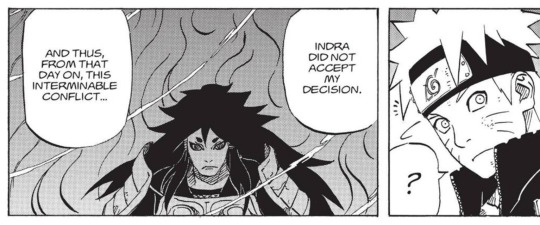
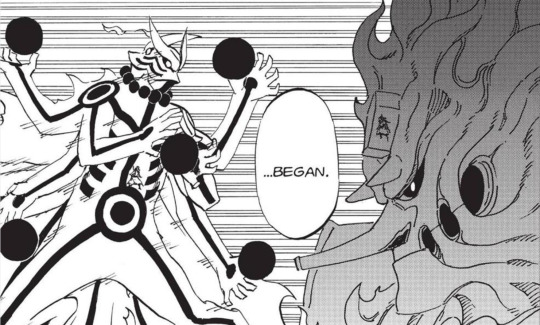
Notably, As(h)ura has its own distinct meanings in Islam (“tenth”) and Buddhism (“titan”/“demigod”), and Indra similarly has a place in Buddhist cosmology, with their own associated roles in each. However, in Buddhism, these references are often derived from the Vedic origins of its spiritual practice, so the Vedas and Sanskrit epics are still an excellent place to begin examining symbolism.
Indra and the Uchiha Clan
In Naruto, Indra is the progenitor of the Uchiha clan, having the Sharingan, an ocular jutsu, and passing it on to his descendants (Naruto Chapter 681). Indra is described in the Rig Veda as follows:
“The singers' for their aid, invoke Indra and Vāyu, swift as mind, The thousand-eyed, the Lords of thought.” (Rig Veda 1.23.3)
The name Indra alludes to several common elements between the Rig Veda and the Uchiha clan as depicted in Naruto: eyesight, might, and dominion over battle. For a more specific reference to Naruto, you can look to Chapter 670, when Hagoromo explains the differences between his sons.
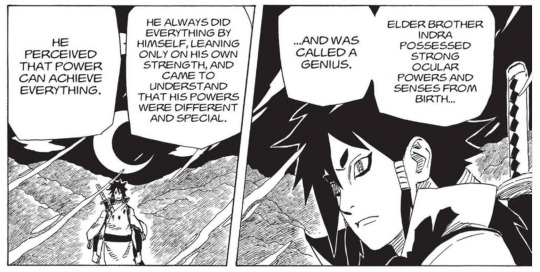
Parallels with Indra in the Rig Veda and the Uchiha clan can be found even earlier than the above chapters. Looking to the subject of the power found in emotions:
“The choirs have stablished Indra King for ever, for victory, him whose anger is resistless: And, for the Bays' Lord, strengthened those he loveth.” (Rig Veda 7.31.12)
These lines in Book 7 describing Indra strongly parallel Tobirama’s description of the Uchiha in Chapter 619 of Naruto, a person being strengthened by love by and overpowered by the force of their own emotion (the Curse of Hatred).
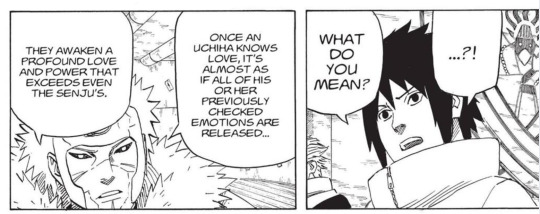
Indra and Sasuke
In Naruto, Sasuke is Indra’s reincarnate (seen below in Naruto Chapter 671). As an Uchiha, both the Sharingan and Curse of Hatred parallels apply to him. But he’s got his own unique connections to Indra in the Rig Veda as well.

In the Naruto anime, Indra is seen using lightning release (Naruto Shippuden Episode 465), which is one of Sasuke’s two chakra natures**, and the one he uses most often.
While it’s likely that the animation studio wished to make Indra and Ashura’s powers parallel the established powers of Naruto and Sasuke, the fact that Indra has lightning release in the anime makes a lot of sense, as the Rig Veda consistently describes Indra as wielding thunder and lightning.
“Even the Heaven and Earth bow down before him, before his very breath the mountains tremble. Known as the Soma-drinker, armed with thunder, who wields the bolt, He, O ye men, is Indra.” (Rig Veda 2.12.13)
Like Sasuke’s lightning release exists in duality with his fire release, Indra also exists in duality with Agni, the fire deity. In Book 10, Indra is described as Agni’s twin, born from the mouth of the Creator, just as the Uchiha emit their Great Fireball Technique from their mouths, i.e. “Indra and Agni from his mouth were born.” (Rig Veda 10.90.13)
Naruto and Ashura
Where Sasuke is associated with Indra through the elements, Naruto shares a specific symbol that is associated with Asura as well: The sun. Savitr is a solar deity, referred to as an Asura in Book 1 of the Rig Veda:
“He, strong of wing, hath lightened up the regions, deep-quivering Asura, the gentle Leader.” (Rig Veda 1.35.7)
While Naruto, after receiving the Sage of Six Paths power, is marked with a symbol for the sun on his hand (seen in Chapter 672).

Savitr is not the only deity to be referred to as an Ashura in the Rig Veda; Indra himself is even described as an Ashura. However, Ashura being associated with sun-like qualities is a recurring theme within the earlier books in the Rig Veda. Ashura is also brought up in the context of Agni, who himself has solar properties and is throughout the Rig Veda also compared to the sun. In fact, the word Ashura only comes up for Agni in the context of the sun. One quote specifically makes the comparison in Agni (the Ashura)’s strength to Indra’s. Found in Book 7:
“PRAISE of the Asura, high imperial Ruler, the Manly One in whom the folk shall triumph- I laud his deeds who is as strong as Indra, and lauding celebrate the Fort-destroyer.” (Rig Veda 7.6.1)
This connection to the sun is maintained throughout these early Hindu scriptures.
It is also worth noting “In who the folk shall triumph” as a parallel to the way Ashura Otsutsuki/the Senju/Naruto, as all of these parties find their strength in cooperating others, and vice versa became their people’s source of strength/hope. This is shown in Chapter 670 when Hagoromo describes Ashura’s power awakening.
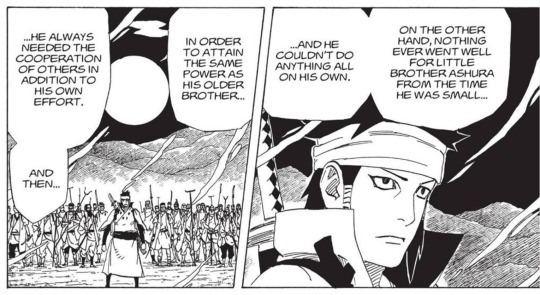

How “In who the folk shall triumph” applies to Naruto is made obvious in the next chapter (Chapter 671) when Naruto talks about his “comrades,” and its application to the Senju is referenced in Chapter 619 i.e. “The Senju clan, who based their strength in love [..]” Strength through loved ones is a recurring theme on both sides of the Otsutsuki brothers, and as well in both aspects of the Rig Veda.
These are certainly not the only parts of the Naruto franchise in which you can see links to Hinduism. But in Indra and Ashura you can find the more prominent and distinct parallels.
Notes
*The translation I used is The Rig Veda by Ralph T. H. Griffith, published in 1896. There are better translations that have been published in more modern times, but this one is easy to navigate and link to for sources. Each of those quotes contains a link to the translated hymn.
(Also, as an academic side-note, the concept of “Hinduism” as a religion did not exist at the time the Vedas were written, but rather is retroactively applied after the amalgamation of various Vedic belief systems in the Indian subcontinent in the 18th century. For a more complex overview, refer to this article. The point being, calling all of this “Hinduism” is the simple version.)
**Chakra is also a concept which is rooted in the Vedas, however, given the elemental nature of chakra in Naruto, and its five-fold varieties, it seems far more likely that it was derived from looking at Tibetan or Tantric Buddhism, so its Hindu origins are a footnote here.
#ashura otsutsuki#indra otsutsuki#sasuke uchiha#naruto uzumaki#uchiha family#otsutsuki family#naruto meta#hinduism#ayesha talks anime#mangacaps#anime history#naruto series#long post#this was a choice#also: i discovered while citing that there's an anime called rg veda#who knew?#some people write naruto essays to cope.jpg#now i can say i used my degree
197 notes
·
View notes
Text
Our Vedas

The Vedas are a collection of hymns and other ancient religious texts written in India between about 1500 and 1000 BCE. It includes elements such as liturgical material as well as mythological accounts, poems, prayers, and formulas considered to be sacred by the Vedic religion.
Origin & Authorship of the Vedas
The origin of the Vedas can be traced back as far as 1500 BCE, when a large group of nomads called the Aryans, coming from central Asia, crossed the Hindu Kush Mountains, migrating into the Indian subcontinent. This was a large migration and used to be seen as an invasion. This invasion hypothesis, however, is not unanimously accepted by scholars today. All we know for certain, mainly through linguistic studies, is that the Aryan language gained ascendency over the local languages in the Indian sub-continent. The language of the Vedas is Sanskrit, an ancestor of most of the modern languages spoken today in South Asia.
Vedic literature is religious in nature and, as such, tends to reflect the worldview & attitudes of the Brahmans or priestly class of ancient India.
We do not know much about the authors of these texts: In Vedic tradition the focus tends to be on the ideas rather than on the authors, which may allow one to look at the message without being influenced by the messenger. Vedic literature is religious in nature and as such tends to reflect the worldview, spiritual preoccupations, and social attitudes of the Brahmans or priestly class of ancient India. The Vedas were first composed sometime around 1500-1000 BCE in the north-western region of the Indian subcontinent - present-day Pakistan and northwest India - and they were transmitted orally over many generations before eventually being committed to writing. Like the Homeric epics, parts of the Vedas were composed in different periods. The oldest of these texts is the Rig-Veda, but it is not possible to establish precise dates for its composition. It is believed that the entire collection was completed by the end of the 2nd millennium BCE.
Content & Structure
The basic Vedic texts are the Samhita “Collections” of the four Vedas:
Rig-Veda “Knowledge of the Hymns of Praise”, for recitation.
Sama-Veda “Knowledge of the Melodies”, for chanting.
Yajur-Veda “Knowledge of the Sacrificial formulas”, for liturgy.
Atharva-Veda “Knowledge of the Magic formulas”, named after a kind of group of priests.
In general, the Vedas have a strong priestly bias, as the priestly class had the monopoly in the edition and transmission of these texts.
Brahma
The Rig-Veda is the largest and most important text of the Vedic collection; it includes 1028 hymns and it is divided into ten books called mandalas. It is a difficult text, written in a very obscure style and filled with metaphors and allusions that are hard to understand for modern reader. The Sama-Veda has verses that are almost entirely from the Rig-Veda, but are arranged in a different way since they are meant to be chanted. The Yajur-Veda is divided into the White and Black Yajur-Veda and contains explanatory prose commentaries on how to perform religious rituals and sacrifices. The Atharva-Veda contains charms and magical incantations and has a more folkloristic style.
The Vedas present a multitude of gods, most of them related to natural forces such as storms, fire & wind.
The Vedas present a multitude of gods, most of them related to natural forces such as storms, fire, and wind. As part of its mythology, Vedic texts contain multiple creation stories, most of them inconsistent with each other. Sometimes the Vedas refer to a particular god as the greatest god of all, and later another god will be regarded as the greatest god of all.
Some elements of the religion practised by the natives of India before Vedic times still persist in the Vedas. The Pre-Vedic religion, the oldest known religion of India, which was found in India before the Aryan migrations, was apparently an animistic and totemic worship of many spirits dwelling in stones, animals, trees, rivers, mountains, and stars. Some of these spirits were good, others were evil, and great magic skill was the only way to control them. Traces of this old religion are still present in the Vedas. In the Atharva-Veda, for example, there are spells to obtain children, to avoid abortion, to prolong life, to ward off evil, to woo sleep, and to harm or destroy enemies.
Gods & Mythology
Despite the fact that the Rig-Veda deals with many gods, there are some who get a lot of attention. More than half the hymns invoke just three top-rated gods of the moment: Indra (250 hymns), Agni (200 hymns), and Soma (just over 100 hymns).
Indra was the head of the ancient Hindu pantheon. He was the Storm-god (sometimes he is referred to as the Sky-god and also as the god of war). The Vedas describe Indra as the god “Who wields the thunderbolt”, and his most celebrated story was the killing of the demon-serpent Vritra. The legend says that Vritra kept all the waters trapped in his mountain lair, and Indra was the one who slew the demon in order to release the waters.
I have slain Vritra, O ye hast’ning Maruts;
I have grown mighty through my own great vigour;
I am the hurler of the bolt of Thunder
For man flow freely now the gleaming waters.
(Mackenzie, Donald, Indian Myth.,54)
This story has a deep significance: The waters are vital for the health of any human community where agriculture is understood as the basis of wealth. By hoarding the waters, the serpent has upset the natural order, preventing the circulation of wealth and nourishment. Indra must thus do battle to restore the balance.
He, who slew the Dragon, freed the Seven Rivers, and drove the
kine forth from the cave of Vala,
Begat the fire between both stones, the spoiler in warrior's battle,
He, O men, is Indra.
(Rig-Veda 2.12.3)
Even the Heaven and the Earth bow down before him, before his
very breath the mountains tremble.
Known as the Soma-drinker, armed with thunder, the wielder of the bolt,
He, O men, is Indra.
(Rig-Veda 2.12.13)
Soma was the personification of the sacred soma plant, whose juice was holy and intoxicating to gods and men. Agni, the god of fire, is often referred to in Vedic literature as the most important god, and is considered to be the flame that lifts the sacrifice to heaven, a symbol of the fiery life and spirit of the world, the “vital spark”, the principle of life in animate and inanimate nature. Agni was seen as a sort of messenger between the realm of the living and the realm of the dead. Cremation was believed to prevent the spirit of the dead from remaining among the living, and for this reason, worshippers of Agni burned their dead, and Agni was responsible for transporting the soul of the dead.
Agni figure, Khajuraho
Another important deity is Varuna, who was initially associated with heaven. Varuna eventually developed into the most ethical and ideal deity of the Vedas, watching the world through his great eye, the sun, and was thought to know everything, to enforce justice and to preserve the world’s smooth functioning. Varuna was also the executor and keeper of the eternal law known as Rita. This was at first the law that established and maintained the stars in their courses; gradually it became also the law of right, the cosmic and moral rhythm which every human must follow to avoid the celestial punishment.
The Vedas also have a hymn to Purusha, a primordial deity who is sacrificed by the other gods: Purusha’s mind became the Moon, his eyes the Sun, his head the Sky, and his feet the Earth. In this same passage we have one of the first indications of a caste system with its four major divisions:
The Brahmans, or priests, came from Purusha’s mouth
The Kshatriyas, or warrior rulers, from Purusha’s arms
The Vaishyas, or the commoners (land-owner, merchants, etc.), from Purusha’s thighs.
The Shudras, or labourers and servants, from Purusha’s feet.
Myths are products of beliefs, and beliefs are products of experience. This story reflects the concerns and experiences of a community based on agricultural lifestyle, where water is seen as one of the most valuable assets. Myths with an agricultural significance are found in many other cultures and dragon-slaying myths are told all over the world, especially in many other Indo-European traditions.
Later Vedic Period
During Vedic times, it was widely believed that rituals were critical to maintain the order of the cosmos and that sacred ceremonies helped the universe to keep working smoothly. In a sense, ceremonies were seen as part of a deal between humans and the gods: Humans performed sacrifices and rituals, and the gods would return their favour under the form of protection and prosperity.
A new set of texts, known as the Brahmanas, was attached to the Vedic collection around the 6th century BCE.
Nature, however, remains indifferent to religious rituals, so when events went awry, society blamed the priests’ incompetence. Priests were not willing to admit their helplessness in trying to master nature and would say that the gods ignored poor quality offers. The solution, the priests said, required more royal support. Brahman priests refused to have their privileges cut, so they developed a new literature which specified, sometimes in a very detailed way, how rituals had to be performed, the precise quantity and quality of material to be used, and the exact pronunciation of sacred formulas. This new set of texts, known as the Brahmanas, was attached to the Vedic collection around the 6th century BCE. The priests claimed that if sacrifices were performed exactly as they said, then the gods would be compelled to respond. When these new rituals also proved to be useless, many sectors of Indian society believed that this whole business of ritual and sacrifice had been taken too far.
During the later Vedic period (from c. 800 to c. 500 BCE), the priestly class was seriously questioned. The rituals, the sacrifices, the detailed rulebooks on ceremonies and sacrifices, all of these religious elements were being gradually rejected. Some of those who were against the traditional Vedic order decided to engage in the pursuit of spiritual progress, living as ascetic hermits, rejecting ordinary material concerns and giving up family life. Some of their speculations and philosophy were compiled into texts called The Upanishads. A number of practices were linked to this new spiritual approach: meditation, celibacy, and fasting, among others.
Around the 7th century BCE, India saw the growth of a culture of world-renunciation, which was a reaction against the Vedic tradition. This culture is the common origin of many Indian religions considered to be “heretical” by the Indian traditional priestly class. Charvaka, Jainism, and Buddhism, among other movements, originated around this time, encouraged by the gradual decay of the priestly orthodoxy. This would result in the end of the Vedic hegemony, shifting the focus of religious life from external rites and sacrifices to internal spiritual quests in the search for answers.
0 notes
Text
언어의 장벽과 성향
2.12.13
언어의 장벽을 사람을 선하게 만드는 경향이 있다. 하지만 언어의 장벽이 조금씩 허물어져가기 시작할때부터 그 사람 본래의 성향이 조금씩 ��타나기 시작한다.
0 notes
Text
Tweeted
Mhairi Hendry & Isabel Ives qualify relatively comfortably, the former winning the 800m in 2.12.13. #bucsathletics http://pic.twitter.com/9iNEHkCNlu
— Vinco (@VincoSport) April 30, 2017
0 notes
Text
Epicism - Responsive Multi-Purpose WordPress Theme
New Post has been published on http://wpelegant.com/epicism-responsive-multi-purpose-wordpress-theme/
Epicism - Responsive Multi-Purpose WordPress Theme
Epicism – Responsive Multi-Purpose WordPress Theme http://themeforest.net/category/wordpress/creative
HTML version also available.
Epicism is a beautiful, responsive, multi-purpose WordPress theme for the masses.
Key Features:
Future proof HTML5 / CSS3 code.
Fully Responsive.
Native WordPress Live Customizer.
Parallax Content.
Beautiful CSS3 Animations.
Per page header & slogans.
WP menu system.
Custom 404 and Search pages.
Unlimited Accent Colors.
Homepage callto action.
Slider Module.
Portfolio Module.
Testimonials Module.
Social Module.
Page templates:
Portfolio.
Contact.
Post formats:
Standard.
Image.
Audio.
Video.
Widgetized sidebar.
Widgetized footer.
Backward compatibility for older browsers.
Automatic CSS combine & minify.
Sortable portfolio.
Lightbox gallery.
Built-in ajax contact form with validation.
Automatic text links.
Lots of built-in shortcodes and classes for easy styling.
Child Theme compatible.
Translation ready.
Sample XML data.
Comprehensive Documentation.
NOTE: Images in demo NOT included in download from Creattica. Copyright their respective owner.
CHANGELOG
26.6.15 - Update prettyPhoto. 13.5.14 - Fixed CSS overflow bug. 12.2.14 - Added LinkedIn icon option. 12.2.14 - Removed deprecated PHP function. 14.1.14 - Fixed a bug in the audio shortcode that broke multiple instances. 2.12.13 - Added touch support for slider. 25.11.13 - Initial Release.
59
Check WordPress Theme
0 notes
Photo

x
194 notes
·
View notes
Audio
i swear i live only listening to 90s songs
62 notes
·
View notes
Video
youtube
Mumford & Sons, Haim, and Ben Howard perform The Weight in NYC last February -
58 notes
·
View notes
Text

4 notes
·
View notes
Text
Day 30
Supernatural Healing of Headaches. God is so good.
Lord, I, out of respectable expectations of You, demand to be empowered and engulfed by your presence. Because You are the only Being that will never disappoint me. And with this faith, I expect to feel You here with me. With boldness, I demand that you meet me here as you have said, "seek and ye shall find." I've been searching for your presence, and during this week, work supernaturally, awesomely, and amazingly through my walk. Stretch my faith. Holy Spirit, consume me with your fire. With your passion, let all temptations, both torturous psychological and physiological desires, be drowned out by your immense power. You are good. You provide. And I will survive thrive. I will live. May I crucify my flesh so that You can feed my Spirit. Physical feeding has nowhere near as much power and supplication as do Your Holy Word, in which I will continue to dwell in. Feed me spiritually, my God.
2 notes
·
View notes
Text
finally saw my favorite band (pierce the veil) live! soooo much love. omg. really. i love you.
1 note
·
View note
Text
awkwardpasta and regina got ahold of my laptop...
1 note
·
View note